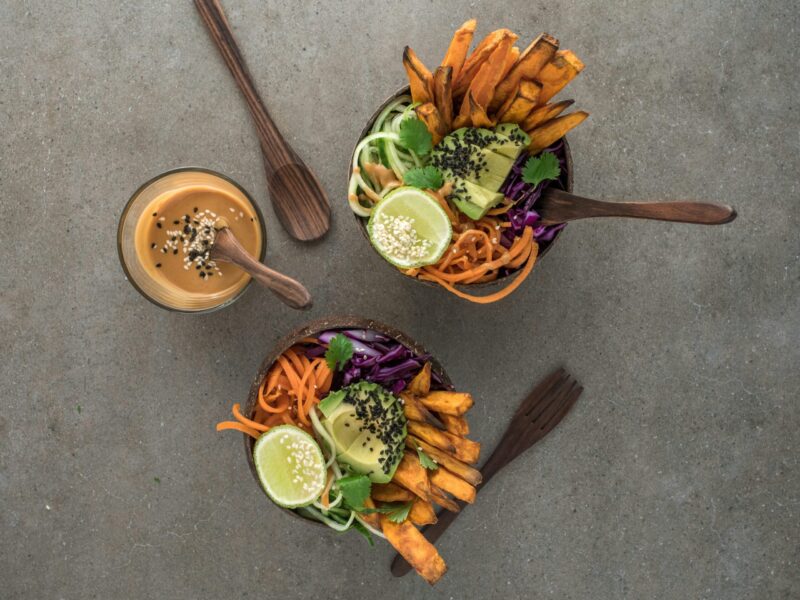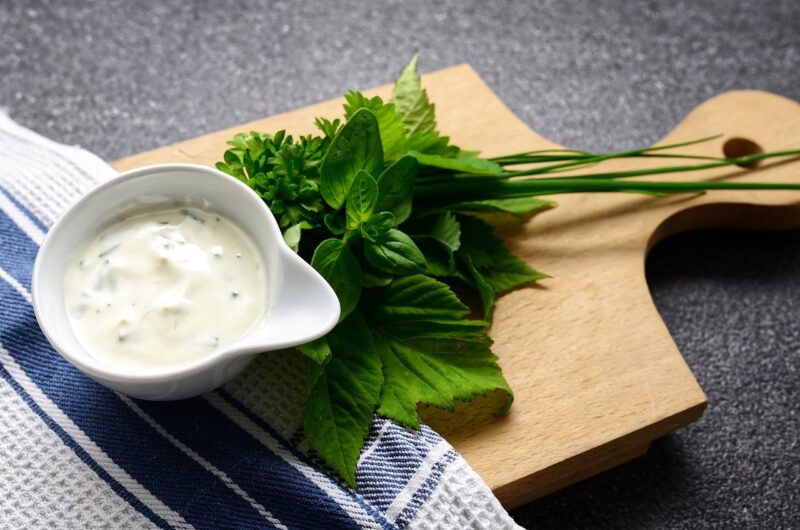April 2024 How to Make Your Own Salad Dressing
By Murphy Brennan
Is the thought of making your own salad dressing intimidating? Salad dressings are a great way to add flavor and fats to meals, even as a dip or a marinade. Most often, we buy premade options at the store. If you want to start making dressings yourself, read on to learn more about the health benefits and how to make them at home!
Benefits of making your own salad dressing

Store-bought dressings often have higher amounts of added salt and sugar, as food manufacturers tend to rely on the beloved tastes of sweet and salty to create product satisfaction. Enter the importance of learning to DIY salad dressing! When making dressings at home, it is easy to customize the ingredients, pack in a nutritional punch, and cater to your personal taste preferences and nutrition needs.
Making salad dressing can be easy, inexpensive, and customizable. Plus, there are so many salad dressing recipes that you can make with ingredients that you likely already have in your kitchen (even odds and ends of extra herbs, onion scraps, etc.). You can choose oils such as heart-healthy olive oil, add antioxidant-rich herbs, spices, and garlic, and use a variety of different acids like Vitamin C-rich citrus juice or unique and flavorful vinegars (pear balsamic, anyone?) to create a signature recipe.
Okay, I’ll give it a shot… but what makes up a salad dressing?
We’re glad you asked! There are four main parts that make up a salad dressing: fat, acid, emulsifier, and seasoning.
- Fat
Fats are really the backbone of any salad dressing. For the most part, the ratio of fat to acid is 3:1 (3 parts fat to 1 part acid). Keep that in mind if you’re freestyling a new dressing recipe! Also, keep in mind that while this is the traditional fat-to-acid ratio, it doesn’t mean that it’s the only ratio. For a lighter-bodied, tangier dressing, you might find a 1:1 ratio of fat to acid is enjoyable!
Some examples of fats that work well with salad dressings:
- Olive oil, avocado oil, canola oil, grapeseed oil, sesame oil
- Note: while olive oil has many health benefits, it also tends to have a noticeable flavor that can mask the flavor of more subtle seasonings. In this case, it is helpful to replace half of the olive oil for a more neutral-flavored oil such as avocado, canola, or grapeseed, or use these oils in place of the olive oil altogether
- Note: sesame oil has an even stronger flavor than olive oil! It’s especially helpful to only use a small portion of the sesame oil along with another neutral-flavored oil to make a dressing that has a pleasant flavor balance
- Peanut butter: yes, this sandwich staple can form the base of fantastic dressings! Other nut butters such as cashew butter can work well, as well as sunflower seed butter as an allergen-friendly alternative
-

Acid
Acids add a little zing to our dressings. Plus, they act as natural preservatives to make our dressings last longer–the acidity inhibits the growth of microorganisms like mold and bacteria that cause spoilage.
Some examples of acids that are great for dressings include:
- Lemon, lime, and orange juice
- Apple cider vinegar
- Balsamic vinegar
- Rice vinegar
- White or red wine vinegar
- Note: try combining different acidic ingredients to create a custom flavor! Some tried-and-true combos are balsamic/red wine vinegar and rice vinegar/orange juice
- Emulsifiers
These are dressing power players! Many natural foods contain emulsifiers, which are compounds that hold hands with both fat-based and water-based ingredients to keep these two unlike liquids mixed together. (Though if dressings do separate, not a problem, just give them a quick stir or shake to recombine.)
Some examples of emulsifiers that are often used in salad dressings are:
- Dijon mustard
- Egg yolks
- Honey
While there are ingredients that are emulsifiers, you may also hear the word emulsify as a verb. This is describing the specific process of mixing oil and acid together to reduce the chances of the dressing “breaking” or separating out. Read more about how to do this in the how-to section below!
- Seasonings
Even though they’re not required, seasonings are a great way to add flavor to your dressings and create signature recipes! Seasonings can also help homemade dressings stay mixed together longer! They act as little blocks that prevent droplets of oils and acids from bumping into other droplets of the same type, and therefore separating out.
Some commonly used seasonings are:
- Salt/pepper
- Rosemary
- Oregano
- Dill
- Thyme
- Garlic (garlic paste, as opposed to minced garlic, can actually be used as an emulsifier)
Putting It All Together- How Do I Mix My Dressing?

The way in which the ingredients are mixed together really does impact how long the dressing stays combined. Let’s talk more about the verb form of ‘emulsify,’ and how we put this into practice:
If whisking a dressing together by hand, whisk your acid, seasonings, and emulsifying ingredients together in a medium bowl (basically, all of the ingredients except oil). Next, constantly whisk these ingredients together while adding in the oil drop by drop. This begins the process of evenly dispersing the oil so that it does not separate out. Add drop by drop for about 10-15 drops, then start to slowly add the oil in a thin stream while continually whisking. The end product should be a silky dressing that will stay combined for a few hours.
Next, if using a blender or food processor, pulse all of the ingredients except the oil together to thoroughly mix. Turn the blender or processor on to a low setting and add the oil in a thin stream through the funnel of either machine until all of the oil is added. This high-speed mixing creates dressings that will stay combined for up to an entire week!
Finally, what happens if you just whisk or shake all of the ingredients together with reckless abandon, without using any technique? Really, you will still maintain all of the great flavors and nutrients, but your dressing may separate out in anywhere from 5-30 minutes. At the end of the day, you only need a serving of dressing to stay together for as long as it takes you to eat your meal. If this is the best technique for you, go for it, and keep your dressing in a jar that you can give a good shake before each use!
I made my dressing…How should I store it?
It’s best to refrigerate your homemade dressing in an air-tight container with a lid to keep it fresh for longer.
Typically, your dressings will last about two weeks if using oils, vinegars, and dried herbs and spices. If you use raw garlic, mayonnaise, dairy-based ingredients, fresh cut herbs, onion, or egg yolk in your recipe, it’s best to use the dressing within 4 days to ensure your dressing is food-safe.
Keep this in mind: when in doubt, throw it out. If it smells funky or has visible signs of mold, it’s time to throw your dressing away. But, remember that separation doesn’t mean the dressing is expired—that’s normal! As mentioned earlier, just give it a good shake or stir and it will be good as new.
Other uses for your dressings:
Salad dressings don’t have to just be used for salads. You could use them as:
- Dipping sauces for protein or vegetables
- The final touch for roasted vegetables (try a homemade balsamic dressing drizzled over crispy brussels sprouts)
- Sandwich/wrap condiments
- Marinades to tenderize meat
- Marinades for vegetables (place sliced bell peppers and carrots into a container, cover with our Chili-Lime Vinaigrette and marinate overnight for a crunchy, flavorful veggie side or topping!)
- Added flavor for a grain bowl
All in all, there are so many awesome ways to create and use salad dressings. Each ingredient has a purpose that comes together to form something delicious. If this post convinced you to start making your own dressings, check out our recipes to get started!
Get to Know our Author:
Brennan is a second year graduate student, pursuing a Master’s degree in Food Science and Nutrition. Her primary areas of interest are eating disorders and sports nutrition. A fun fact about Brennan: she was named after her dad’s childhood dog.
More Information
For additional resources for healthy eating, check out these programs from our registered dietitian nutritionists. Find delicious and healthy recipes on our Recipes page! More health tips are also available at the College of Health and Human Sciences Pinterest board. Lastly, don’t forget to sign up for the KRNC monthly newsletter!


